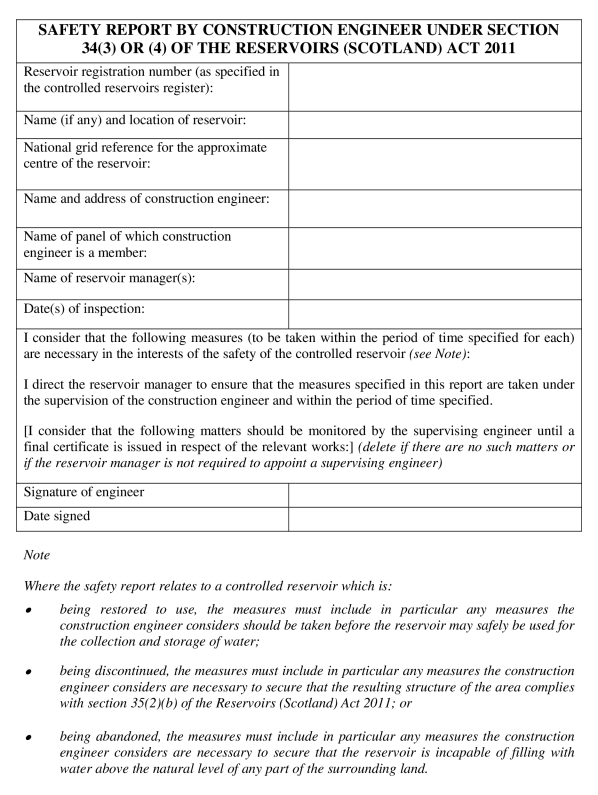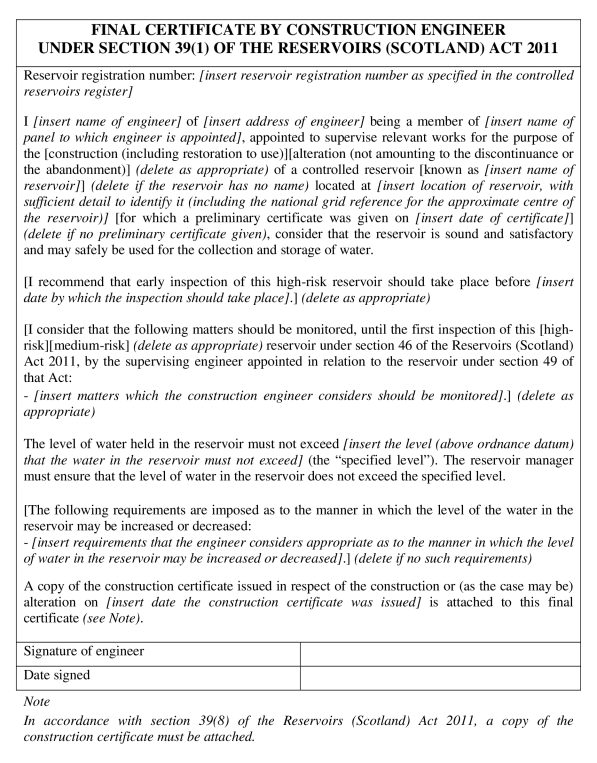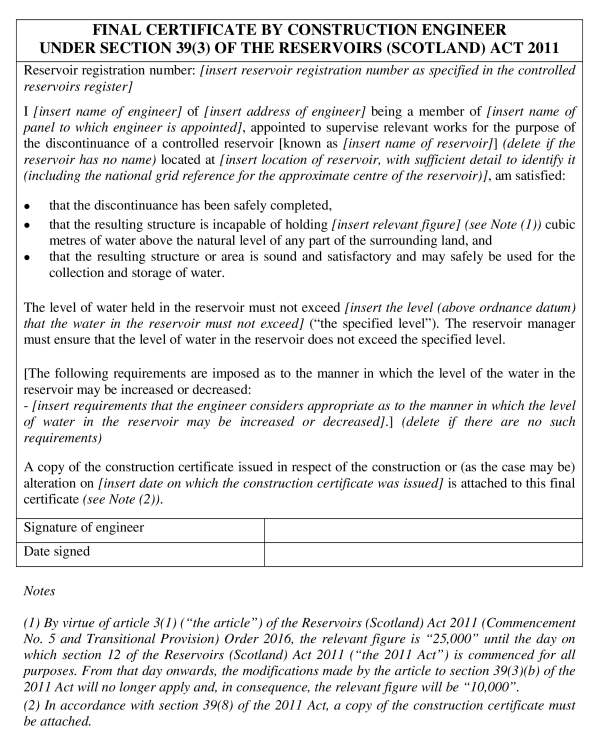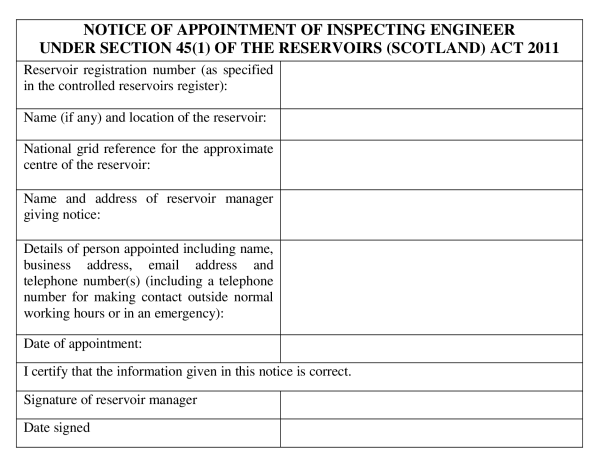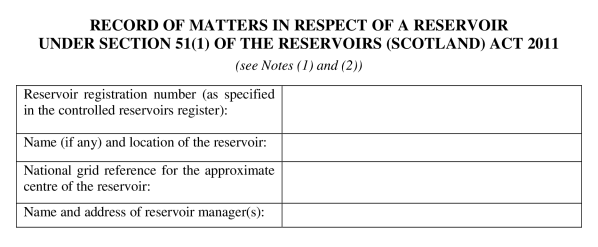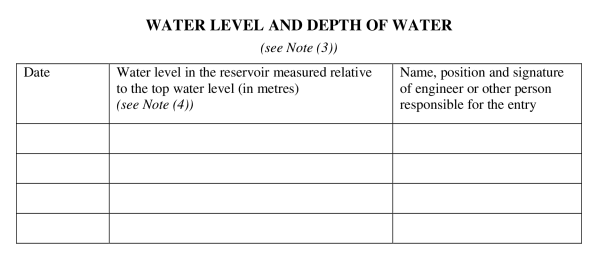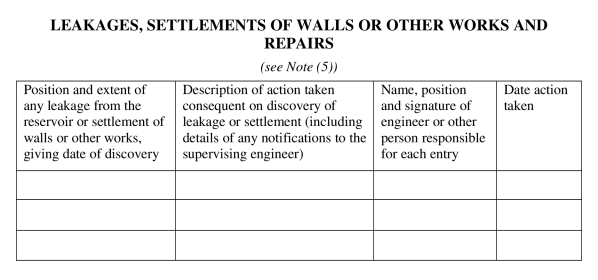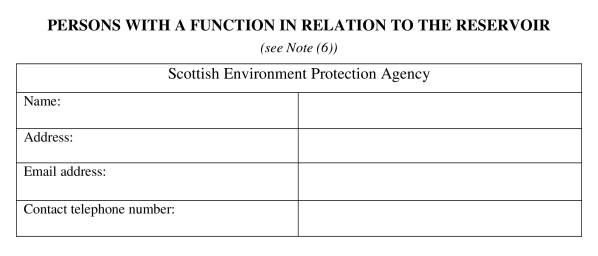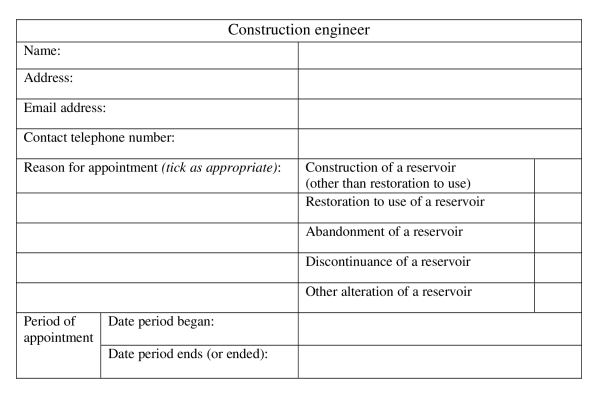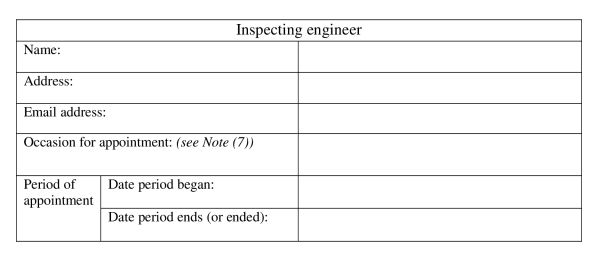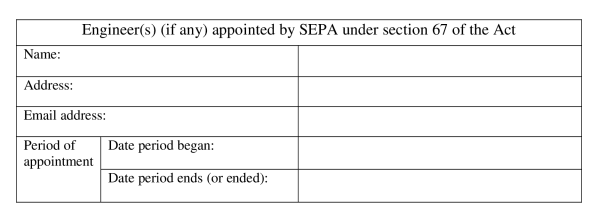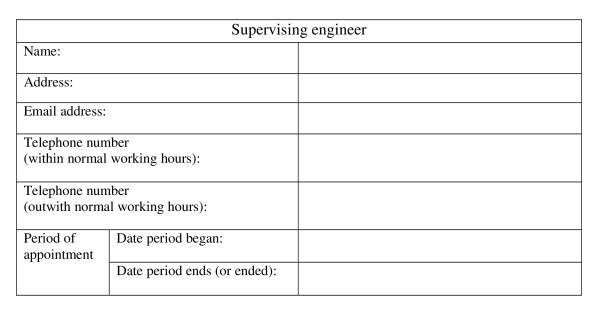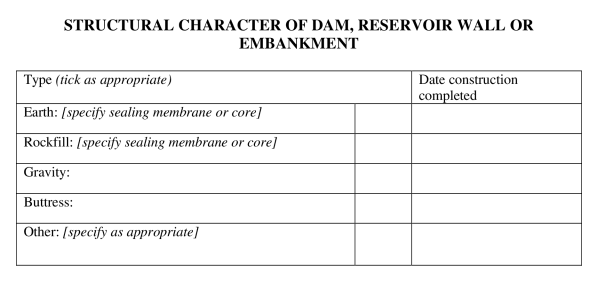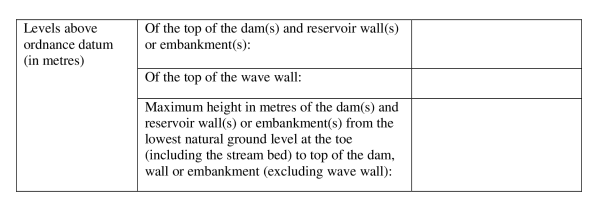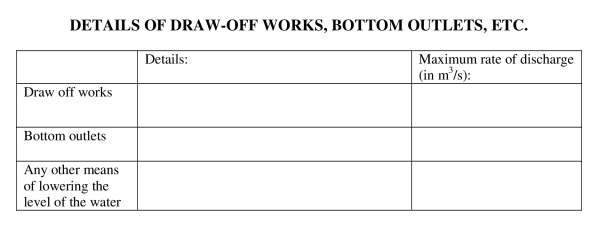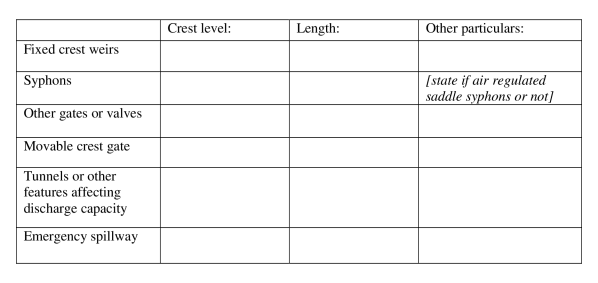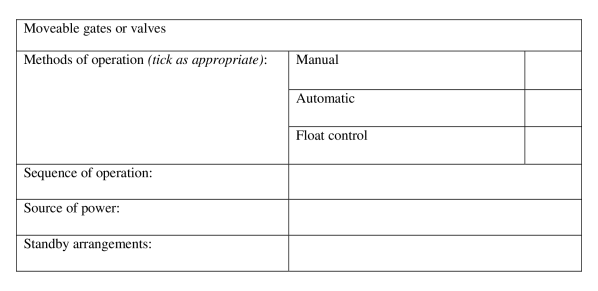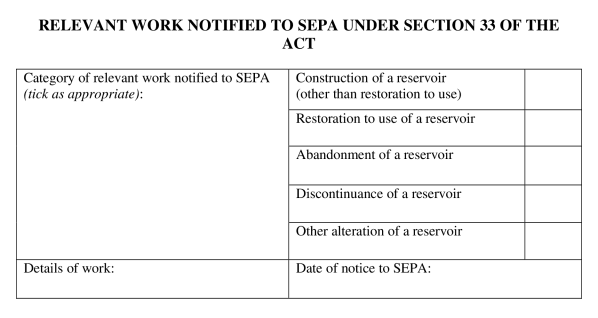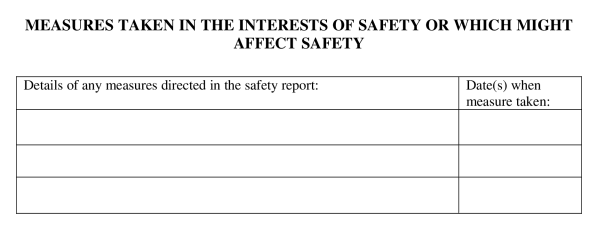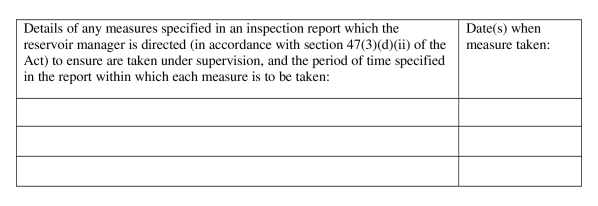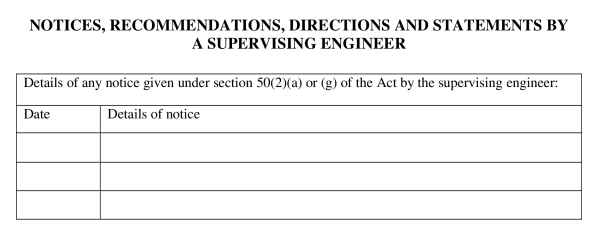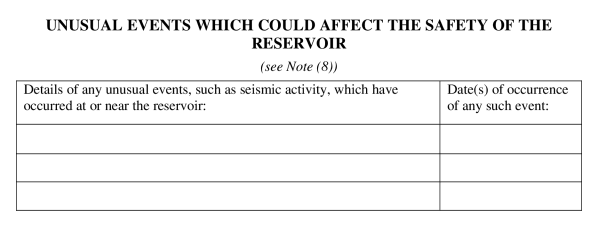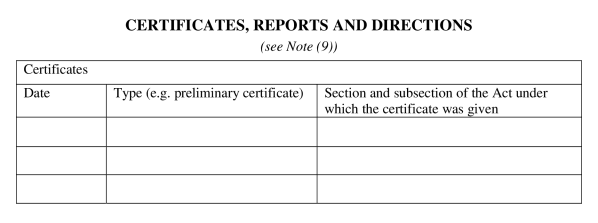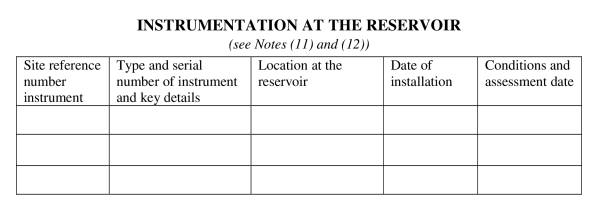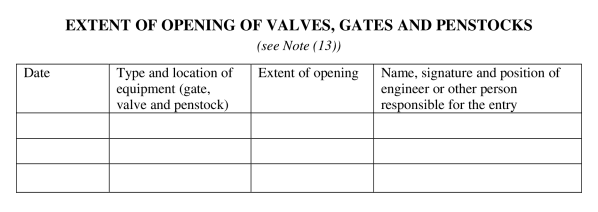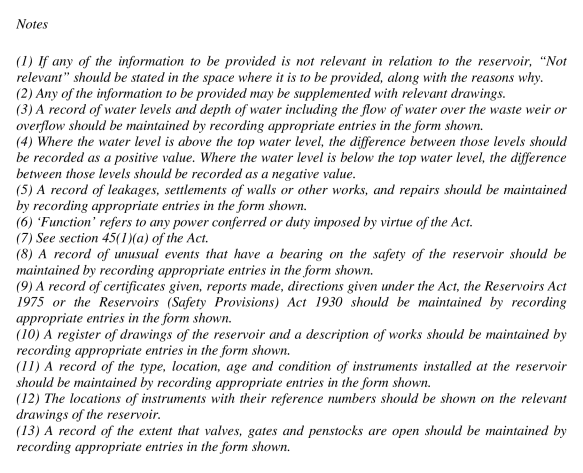Scottish Statutory Instruments
2016 No. 43
Flood Risk Management
Water Supply
The Reservoirs (Scotland) Regulations 2016
Made
26th January 2016
Laid before the Scottish Parliament
28th January 2016
Coming into force
1st April 2016
The Scottish Ministers make the following Regulations in exercise of the powers conferred by sections 1(6)(b), 2(3), 9(3)(a), 10(2), 14(1), (3) and (4), 23(8), 24(7), 28(7) and (8), 30(2), 35(1)(d), 38(3)(c), 51(1)(e) and (2), 56(3), 64(1), 105 and 114(2)(b) of the Reservoirs (Scotland) Act 2011(1) and all other powers enabling them to do so.
In accordance with section 14(2) of that Act, in making regulations under section 14(1), the Scottish Ministers have had regard to the reasonable cost of the exercise of the functions in respect of which fees are to be charged.
PART 1INTRODUCTORY
Citation, commencement and interpretation
1.—(1) These Regulations may be cited as the Reservoirs (Scotland) Regulations 2016 and come into force on 1st April 2016.
(2) In these Regulations—
“the Act” means the Reservoirs (Scotland) Act 2011;
“the 1930 Act” means the Reservoirs (Safety Provisions) Act 1930(2);
“the 1975 Act” means the Reservoirs Act 1975(3);
“1975 Act panel” means any of the following (established under section 4 of the 1975 Act)—
all reservoirs panel;
non-impounding reservoirs panel;
service reservoirs panel; and
supervising engineers panel;
“2011 Act panel” means any of the following (established under section 27(a) of the Act)—
All Reservoirs (Scotland) Panel;
Non-Impounding Reservoirs (Scotland) Panel;
Service Reservoirs (Scotland) Panel; and
Supervising Engineers (Scotland) Panel;
“adjacent” includes below;
“annual subsistence fee” means a fee that SEPA may charge under regulation 15(1);
“charging scheme” means a scheme of charges prepared by SEPA under regulation 19;
“eligible person” means a person who—
would have been a member of a 1975 Act panel throughout the transitional period if the term of that membership (so far as it extended to Scotland) had not ceased by virtue of the repeal of the 1975 Act; and
wishes to be appointed to the corresponding 2011 Act panel;
“fetch”, in relation to a reservoir, means the effective length of the reservoir over which wind can build up waves;
“financial year” means a period of 12 months ending with 31st March;
“natural level” has the meaning it has in regulation 5;
“new manager fee” means a fee that SEPA may charge under regulation 17(1);
“registration fee” means a fee that SEPA may charge under regulation 13(1);
“the relevant engineer” has the meaning it has in section 61(4) (appointment of referee) of the Act;
“surrounding land” has the meaning it has in regulation 5;
“top water level” has the meaning it has in regulation 3(3); and
“transitional period” means the period beginning with 1st April 2015 and ending with the date on which the statement referred to in paragraph 5 of Schedule 3 was signed and dated.
(3) In these Regulations, a reference to any panel in one of the following sub-paragraphs is to be construed as corresponding only to the other panel in that sub-paragraph—
(a)all reservoirs panel and All Reservoirs (Scotland) Panel;
(b)non-impounding reservoirs panel and Non-Impounding Reservoirs (Scotland) Panel;
(c)service reservoirs panel and Service Reservoirs (Scotland) Panel; and
(d)supervising engineers panel and Supervising Engineers (Scotland) Panel.
(4) In these Regulations—
(a)where a form in a Schedule contains italicised words in round brackets or a Note, those words and brackets and any such Note may be omitted from the completed form;
(b)where a form in a Schedule contains italicised words in square brackets, those words and brackets are, in the completed form, to be substituted with the information specified by those words; and
(c)where anything is to be done “in writing” that includes an electronic communication, as defined in section 15(1) of the Electronic Communications Act 2000(4), which is capable of being reproduced.
PART 2CONTROLLED RESERVOIRS
Lochs and other areas to be considered artificial or partly artificial
2. For the purposes of section 1(2) of the Act, a loch or other area is to be considered artificial (or partly artificial) if it was created or enlarged as a result of human activity.
Calculation of volume of water that a structure or area is capable of holding
3.—(1) For the purposes of Part 1 of the Act, the volume of water that a structure, loch or other area referred to in paragraph (a) or (b) of section 1(2) of the Act (“the reservoir”) is capable of holding above the natural level of any part of the surrounding land is to be calculated by measuring the maximum volume of water (in cubic metres) which is capable of being held in the reservoir—
(a)above the bed of the reservoir; and
(b)between the toe of the reservoir and its top water level.
(2) Water not capable of flowing out of the reservoir over natural ground in the event of an uncontrolled release of water from the reservoir must not be included in the calculation.
(3) In paragraph (1)—
“bed”, in relation to a reservoir, includes any silt or other material that is incapable of flowing out of the reservoir over natural ground in the event of an uncontrolled release of water from the reservoir;
“toe” means the point on the downstream side of a dam, reservoir wall or embankment forming part of the reservoir where the base of the dam, reservoir wall or embankment, as the case may be, meets the lowest level of the natural ground (which remains after the construction, or any alteration, of the reservoir) of any part of the land adjacent to the reservoir, including the lowest bed level of any watercourse; and
“top water level” means—
in the case of a reservoir with a fixed overflow sill, the lowest crest level of that sill;
in the case of a reservoir the overflow from which is controlled wholly or partly by moveable gates, syphons or otherwise, the maximum level to which water may be held exclusive of any provision for flood storage; or
in the case of a reservoir designed for the purposes of holding back floodwater, the maximum level to which floodwater may be held during any flood event exclusive of any provision for overflow.
Calculation of volume of water that a structure or area is capable of releasing
4. For the purposes of subsection (3) of section 1 of the Act, the volume of water that is capable of being released from a combination of structures or areas referred to in that subsection (“the combination”) is to be calculated by measuring the maximum volume of water (in cubic metres) which is capable of flowing out of the combination over natural ground in the event of an uncontrolled release of water from the combination.
Meaning of “natural level” and “surrounding land”
5.—(1) For the purposes of Part 1 of the Act—
“natural level”—
in relation to any part of surrounding land which would remain covered with residual water after an uncontrolled release of water from the structure, loch or other area (to which the land relates), means the level of the surface of the residual water; and
in relation to any other part of that surrounding land, means the level of the natural ground remaining after the construction, or any alteration, of the reservoir; and
“surrounding land”, in relation to a structure, loch or other area referred to in paragraph (a) or (b) of section 1(2) of the Act (“the reservoir”), means the land adjacent to the reservoir (including any land which would be adjacent to water held by the reservoir when the reservoir is holding the maximum volume of water that it is capable of holding).
(2) In the definition of “natural level” in paragraph (1), a reference to “residual water” is a reference to water which would not be capable of flowing out of the structure, loch or other area in question over natural ground in the event of an uncontrolled release of water from the reservoir.
Structures or areas which are not controlled reservoirs
6.—(1) Ponds within extractive waste areas or waste facilities constitute the structures or areas referred to in paragraph (a) of section 2(2) of the Act.
(2) In paragraph (1), references to “ponds”, “extractive waste areas” and “waste facilities” are to be construed in accordance with the meaning given to the corresponding word or expression in regulation 2(1) of the Management of Extractive Waste (Scotland) Regulations 2010(5).
7. Weirs which are not capable of holding water above the natural banks of any part of a watercourse constitute the structures or areas in paragraph (c) of section 2(2) of the Act.
8.—(1) Road and railway embankments which are designed to drain water (including from any upstream areas) through the embankment, subject to paragraph (2), constitute the structures or areas referred to in paragraph (f) of section 2(2) of the Act.
(2) The road and railway embankments referred to in paragraph (1) do not constitute the structures or areas referred to in paragraph (f) of section 2(2) of the Act if drains which are designed to drain water (including from any upstream areas) through the embankment are—
(a)artificially blocked for the purposes of using areas upstream to hold water; or
(b)constructed so that water is held above natural ground level.
9. A structure or area created as a result of the construction of dams by beavers is not a controlled reservoir(6) (and is not to be taken into account in relation to what is to be treated as a controlled reservoir for the purposes of section 1(3) or (4) of the Act).
PART 3REGISTRATION
Controlled reservoirs register: additional information
10.—(1) From the date on which a controlled reservoir is required to be registered under the Act, the controlled reservoirs register must contain the business address of any construction engineer, inspecting engineer, other qualified civil engineer or supervising engineer appointed at any time in relation to the reservoir.
(2) From the date on which a 1975 Act reservoir is required to be registered under the Act, the controlled reservoirs register must contain the name and business address of any construction engineer, inspecting engineer or supervising engineer appointed immediately before that date (or, if any such engineer was not appointed at that point, the last such engineer appointed) under the 1975 Act in relation to the reservoir, and the period of any such appointment.
(3) In paragraph (2)—
“1975 Act reservoir” means—
a controlled reservoir which was, immediately before 1st April 2015, required to be registered in a register maintained under section 2(2) of the 1975 Act; or
a controlled reservoir which—
was not, immediately before 1st April 2015, required to be registered in a register maintained under section 2(2) of the 1975 Act; and
was, on or after that date, required to be registered in a register maintained under section 2(2) of the 1975 Act;
“construction engineer” has the meaning it had in section 6(1) of the 1975 Act;
“inspecting engineer” has the meaning it had in section 10(1) of the 1975 Act; and
“supervising engineer” has the meaning it had in section 12(1) of the 1975 Act.
Information that a reservoir manager must register with SEPA
11. The reservoir manager of a controlled reservoir must, under section 10(1) of the Act, register—
(a)the information and documents (in relation to the reservoir) specified in Schedule 1;
(b)if the reservoir is a reservoir to which section 11(2) of the Act applies—
(i)a copy of the most recent report of an inspection under section 10 of the 1975 Act in relation to that reservoir;
(ii)the name, business address, email address and telephone number(s) of the inspecting engineer who carried out the inspection to which the report relates; and
(iii)to the extent known or readily obtainable by the reservoir manager, the name, business address, email address and telephone number(s) (including a telephone number for making contact outside normal working hours or in an emergency) of any—
(aa)construction engineer;
(bb)inspecting engineer; or
(cc)supervising engineer,
appointed immediately before the date on which the reservoir was registered (or, if any such engineer was not appointed at that point, the last such engineer appointed) under the 1975 Act in relation to the reservoir (and the period of any such appointment); and
(c)if the reservoir is required to be registered in accordance with section 13 of the Act, a map showing the area of land which, in the event of an uncontrolled release of water from the reservoir, would be likely to be flooded.
Time by which changes to information must be registered
12. Where there is a change to information referred to in regulation 11, the change to the information must be registered by the reservoir manager under section 10(1) of the Act within 28 days beginning with the date on which the information changed.
Registration fees: general
13.—(1) Subject to regulation 14, SEPA may charge the reservoir manager of each controlled reservoir a fee in relation to the registration by that manager of the controlled reservoir under section 10(1) of the Act.
(2) The reservoir manager must pay the registration fee to SEPA.
(3) The registration fee is recoverable as a civil debt.
Registration fees: determination and charging
14.—(1) SEPA must determine the registration fee to be included in its charging scheme having regard to the likely average cost to SEPA of registering a controlled reservoir.
(2) The registration fee must accompany the information to be registered under section 10(1) of the Act.
(3) SEPA must not charge a registration fee in connection with any registration under section 10(1) of the Act where the information to be registered was received by SEPA before 1st October 2015.
Annual subsistence fee: general
15.—(1) Subject to regulation 16, SEPA may charge the reservoir manager of each controlled reservoir which has been given a risk designation under the Act an annual fee in relation to the performance by SEPA of its functions under Part 1 of the Act.
(2) The reservoir manager must pay the annual subsistence fee to SEPA.
(3) The annual subsistence fee is recoverable as a civil debt.
Annual subsistence fee: determination and charging
16.—(1) SEPA must determine the amounts of the annual subsistence fee to be included in its charging scheme having regard to—
(a)its functions under Part 1 of the Act;
(b)the likely cost to SEPA of carrying out those functions;
(c)the number of controlled reservoirs that have been or are likely to be registered; and
(d)the categories of risk designation.
(2) Different amounts of annual subsistence fee may be set for controlled reservoirs with different risk designations.
(3) The annual subsistence fee is chargeable in respect of each financial year.
(4) The annual subsistence fee is payable at the beginning of the financial year in respect of which it is chargeable.
(5) Where a controlled reservoir is given a first risk designation under section 19 of the Act during any financial year, the annual subsistence fee for that financial year must be such proportion of the annual subsistence fee which would otherwise be payable under these Regulations as relates to the period of that year for which the reservoir had a risk designation.
(6) Where a different risk designation is given following a review under Chapter 3 of Part 1 of the Act, the risk designation for the purposes of determining the amount of the annual subsistence fee in any given financial year is the risk designation that applied on 1st April of that year.
(7) Where a controlled reservoir has more than one reservoir manager and one or more nominations are made under section 4(3) of the Act such that a single reservoir manager (“the point of contact manager”) has been nominated by the other managers to fulfil the following functions under Part 1 of the Act—
(a)making representations to SEPA within the meaning of section 18(4) of the Act;
(b)applying for a review of a risk designation under section 23(1) of the Act;
(c)giving notice to SEPA of proposed works under section 33(1) of the Act;
(d)giving notice to SEPA of the appointment of a construction engineer under section 33(2)(b) of the Act;
(e)giving notice to SEPA of the appointment of an inspecting engineer under section 45(1)(b) of the Act;
(f)giving notice to SEPA of the appointment of any other qualified engineer under section 48(2)(b) of the Act;
(g)giving notice to SEPA of the appointment of a supervising engineer under section 49(1)(b) of the Act;
(h)submitting flood plans to SEPA under section 55(3)(f) of the Act;
(i)giving notice to SEPA of any relevant appointments under section 65(2)(b) of the Act;
(j)giving SEPA notice of revocation of appointment of an engineer under section 103(1) of the Act; and
(k)giving SEPA a copy of a notice of resignation by an engineer under section 103(2) of the Act,
SEPA may only charge the point of contact manager the annual subsistence fee in respect of that controlled reservoir.
(8) SEPA must not charge an annual subsistence fee for the financial year ending 31st March 2016.
Transfer fees: general
17.—(1) Subject to regulation 18, SEPA may charge the reservoir manager of a controlled reservoir a fee in relation to a notice given to SEPA by that manager under section 15(2) of the Act.
(2) The reservoir manager must pay the new manager fee to SEPA.
(3) The new manager fee is recoverable as a civil debt.
Transfer fees: determination and charging
18.—(1) SEPA must determine the amount of any new manager fee to be included in its charging scheme having regard to the likely cost to SEPA of performing SEPA’s functions under section 15 of the Act.
(2) A notice under section 15(2) of the Act must be accompanied by any new manager fee.
(3) SEPA must not charge a new manager fee in respect of any notice under section 15(2) of the Act which was given to SEPA before 1st October 2015.
Charging schemes
19.—(1) SEPA must—
(a)set out its fees to be charged under this Part in a published charging scheme; and
(b)consult such persons as SEPA considers likely to be affected by the scheme before it publishes or revises a scheme.
(2) SEPA must, at least once in every three year period beginning with 1st April 2016, review the scheme.
(3) Following a review, SEPA may revise the scheme.
PART 4RISK DESIGNATION
Applications for review of risk designations under section 23 of the Act
20.—(1) An application to SEPA under section 23(1) (review of SEPA’s decisions giving risk designations) of the Act must—
(a)be made in writing; and
(b)if a fee is charged in relation to the application under section 23(6) of the Act, be accompanied by the fee.
(2) When giving notice to a reservoir manager of a controlled reservoir of a risk designation under section 19(5) or 21(4) of the Act, SEPA must inform the reservoir manager as to—
(a)where to send an application for a review under section 23(1) of the Act; and
(b)the information to be provided with any such application.
Appeals to the Scottish Ministers following a review by SEPA of risk designation
21.—(1) An appeal to the Scottish Ministers under section 24(1) (appeal to the Scottish Ministers following SEPA’s review) of the Act must be made by notice in writing (“notice of appeal”).
(2) The notice of appeal must contain—
(a)a statement of the grounds of appeal;
(b)a copy of the notice of the decision given by SEPA under section 23(5) of the Act to which the appeal relates; and
(c)a copy of any relevant correspondence between the person making the appeal (“the appellant”) and SEPA.
(3) The appellant must, at the same time as making any such appeal to the Scottish Ministers, send a copy of the notice of appeal to SEPA.
(4) SEPA may, within a period of 28 days beginning with the day on which it receives a copy of the notice of appeal, make representations in writing to the Scottish Ministers.
(5) SEPA must, at the same time as making representations under paragraph (4), send a copy of those representations to the appellant.
(6) The appellant may, within a period of 21 days beginning with the day on which the appellant receives a copy of any representations made by SEPA under paragraph (4), make representations in writing to the Scottish Ministers in respect of SEPA’s representations.
(7) The appellant must, at the same time as making any representations to the Scottish Ministers under paragraph (6), send a copy of those representations to SEPA.
(8) The appellant may withdraw an appeal by notice in writing to the Scottish Ministers.
(9) The appellant must, at the same time as sending a withdrawal notice under paragraph (8), send a copy of the notice to SEPA.
(10) Before determining an appeal, the Scottish Ministers may give the appellant and SEPA an opportunity to appear before, and be heard by, any engineer appointed under section 24(4) of the Act to make recommendations to the Scottish Ministers about the risk designation to which the appeal relates.
PART 5PANELS OF RESERVOIR ENGINEERS
Applications for appointment: general
22.—(1) An application for appointment (including re-appointment) to a panel under section 28(1) of the Act must be made in writing to the Scottish Ministers.
(2) Except where the application is made in accordance with regulation 23(1), the application must—
(a)contain the information specified in Schedule 2; and
(b)if a fee is charged to the applicant under regulation 24 in connection with the application, be accompanied by the fee.
Applications for appointment: eligible persons
23.—(1) Where an application for appointment to a panel under section 28(1) of the Act is made by an eligible person, the application must contain the information specified in Schedule 3.
(2) Where an application is made by an eligible person in accordance with paragraph (1), the application for appointment must be only in respect of a period which does not exceed the period which would have remained of the term of the person’s appointment to the corresponding 1975 Act panel if the term of that appointment (so far as it extended to Scotland) had not ceased by virtue of the repeal of the 1975 Act.
Fees in connection with applications for membership of panels
24.—(1) Subject to paragraph (2), the Scottish Ministers may charge a fee of £385 in connection with an application for membership of (including re-appointment to) a 2011 Act panel (“membership fee”).
(2) The Scottish Ministers must not charge a membership fee if the application referred to in paragraph (1) is made by a person who—
(a)at or around the same time, applies in substantially the same terms to the Secretary of State under the 1975 Act to be placed on a corresponding 1975 Act panel; and
(b)the application to be placed on the corresponding 1975 Act panel is accompanied by the prescribed fee under that Act.
Applications for review of decisions to appoint or remove civil engineers from panels etc.
25.—(1) An application for a review of a decision under section 30(1) of the Act must be made in writing to the Scottish Ministers.
(2) The application must contain the information specified in Schedule 4.
PART 6CONSTRUCTION OR ALTERATION OF CONTROLLED RESERVOIRS
Notice of relevant works
26. A notice of proposed relevant works by a reservoir manager under section 33(1) (notice to SEPA and appointment of construction engineer) of the Act must contain the information specified in Schedule 5.
Safety report
27. A safety report by a construction engineer under section 34 (inspection, reports, supervision of works etc. by construction engineer) of the Act must—
(a)in addition to the matters required by section 35(1)(a) to (c) (safety reports) of the Act, include the other matters specified in the form (as read with the Note to the form) in Schedule 6; and
(b)be in the form set out in Schedule 6.
Safety measure certificate
28. A safety measure certificate by a construction engineer under section 36(2) (safety reports: compliance) of the Act must be in the form set out in Schedule 7.
Preliminary certificate
29. A preliminary certificate by a construction engineer under section 37 (preliminary certificates) of the Act must be in the form set out in Schedule 8.
Construction certificate
30. A construction certificate by a construction engineer under section 38 (construction certificates) of the Act must—
(a)in addition to the information required by subsection (3)(a) and (b) of that section, contain the other information specified in the form (as read with the Note to the form) in Schedule 9; and
(b)be in the form set out in Schedule 9.
Final certificates
31.—(1) A final certificate by a construction engineer under section 39(1) (final certificates) of the Act must be in the form set out in Part 1 of Schedule 10.
(2) A final certificate by a construction engineer under section 39(3) (final certificates) of the Act must be in the form set out in Part 2 of Schedule 10.
(3) A final certificate by a construction engineer under section 39(5) (final certificates) of the Act must be in the form set out in Part 3 of Schedule 10.
PART 7OTHER REQUIREMENTS: HIGH-RISK RESERVOIRS AND MEDIUM-RISK RESERVOIRS
Notice of appointment of inspecting engineer
32. A notice by a reservoir manager under section 45(1) (appointment of inspecting engineer etc.) of the Act must—
(a)include the content specified in the form in Schedule 11; and
(b)be in the form set out in Schedule 11.
Inspection report
33. An inspection report by an inspecting engineer under section 47(1)(b) (inspections: duties of inspecting engineers etc.) of the Act must be in the form set out in Schedule 12.
Inspection report: compliance certificates
34.—(1) An interim inspection compliance certificate by an inspecting engineer under section 48(3) (inspection reports: compliance) of the Act must be in the form set out in Part 1 of Schedule 13.
(2) An inspection compliance certificate by an inspecting engineer under section 48(5) (inspection reports: compliance) of the Act must be in the form set out in Part 2 of Schedule 13.
Notice of appointment of supervising engineer
35. A notice by a reservoir manager under section 49(1) (appointment of supervising engineers etc.) of the Act must—
(a)include the content specified in the form in Schedule 14; and
(b)be in the form set out in Schedule 14.
Statement by supervising engineer
36. A statement by a supervising engineer under section 50(8) (supervising engineer and monitoring of reservoir) of the Act must be in the form set out in Schedule 15.
Recording of water levels etc. and record keeping
37.—(1) The record of matters (“the recorded matters”) to be maintained under section 51(1) (recording of water levels etc. and record keeping) of the Act must, in addition to the matters required by subsection (1)(a) to (d) of that section, include the other matters specified in Schedule 16.
(2) The information specified in the form (as read with the Notes to the form) in Schedule 17 is to be included in relation to the recorded matters.
(3) The record to be maintained under section 51(1) of the Act must be in the form set out in Schedule 17.
PART 8OTHER REQUIREMENTS: CONTROLLED RESERVOIRS
Information about repairs
38. The information about repairs to be contained in a record of relevant documents pursuant to section 56(3) (maintenance of records) of the Act must be in the form set out in Schedule 18.
PART 9DISPUTE REFERRAL
Time within which a referee may be appointed by agreement
39. The time within which a referee (“the referee”) may be appointed under section 61(1)(a) (appointment of referee) of the Act by agreement between a reservoir manager and the relevant engineer, is a period of 60 days beginning with, as the case may be—
(a)the day on which the safety report or the inspection report, which contains the direction which is to be referred to the referee by the reservoir manager under section 59(2) of the Act, was given to the reservoir manager; or
(b)the day on which the preliminary certificate or the final certificate, which mentions the matters which are to be referred to the referee by the reservoir manager under section 60(1) of the Act, was given to the reservoir manager.
Time within which a request may be made for an appointment
40. The time within which a request to the Scottish Ministers for the appointment of a referee (“the referee”) under section 61(1)(b) of the Act may be made, is a period of 70 days beginning with, as the case may be—
(a)the day on which the safety report or the inspection report, which contains the direction which is to be referred to the referee by the reservoir manager under section 59(2) of the Act, was given to the reservoir manager; or
(b)the day on which the preliminary certificate or the final certificate, which mentions any matter which is to be referred to the referee by the reservoir manager under section 60(1) of the Act, was given to the reservoir manager.
Manner of the request for an appointment
41.—(1) Any request to the Scottish Ministers for the appointment of a referee (“the referee”) under section 61(1)(b) of the Act must be made in writing.
(2) Where the subject of the referral to be made to the referee is a direction contained in a safety report or an inspection report, the request must be accompanied by—
(a)the safety report or the inspection report containing the direction;
(b)a statement specifying the terms of the direction in the safety report or, as the case may be, the inspection report for which the appointment is requested;
(c)where the report containing the direction is a safety report, any safety measure certificate given in relation to the report; and
(d)where the report containing the direction is an inspection report, any interim inspection compliance certificate given in relation to the report.
(3) Where the subject of the referral to be made to the referee is a matter mentioned in a preliminary certificate or a final certificate, the request must be accompanied by—
(a)the preliminary certificate or the final certificate which mentions the matter; and
(b)a statement specifying the matter in the preliminary certificate or, as the case may be, the final certificate for which the appointment is requested.
Procedure before the referee
42.—(1) A referee appointed under section 61(1) of the Act must, within a period of 28 days beginning with the day on which the referee was appointed, invite the reservoir manager in question to give to the referee a statement in writing of the grounds of challenge under, as the case may be—
(a)section 59(2) (referral to referee: directions in safety report or inspection report) of the Act; or
(b)section 60(1) (referral to referee: requirements in preliminary certificate or final certificate) of the Act.
(2) Where a reservoir manager is invited to give a statement under paragraph (1), the reservoir manager must give the statement in writing to the referee within a period of 28 days beginning with the day on which the reservoir manager was invited to do so.
(3) Where a referee is given a statement in accordance with paragraph (2), the referee must give a copy of the statement to the relevant engineer and invite the engineer to give to the referee observations in writing in relation to the statement within a period of 28 days beginning with the day on which the engineer was given the copy of the statement.
(4) Where a referee is given observations in accordance with paragraph (3), the referee—
(a)must give a copy of the observations to the reservoir manager and invite the manager to give to the referee comments in writing in relation to the observations within a period of 21 days beginning with the day on which the manager was given the copy of the observations; and
(b)may arrange to meet the reservoir manager and the relevant engineer, or their representatives, to hear any observations that either party may wish to make orally.
(5) The referee may carry out an investigation and this may include an inspection of the reservoir in question (with or without the reservoir manager and the relevant engineer, or their representatives) before making a decision under, as the case may be—
(a)section 62(2) (powers of referee: referral under section 59(2)) of the Act; or
(b)section 63(2) (powers of referee: referral under section 60(1)) of the Act.
Investigation and proceedings: expenses
43. The cost of any investigation and proceedings (including the referee’s remuneration) arising in consequence of a referral made under section 59(2) or section 60(1) of the Act are expenses for the purposes of section 64(2) of the Act (expenses of the investigation and proceedings to be paid by the reservoir manager who makes the referral).
PART 10REVOCATIONS
Revocations
44. The instruments specified in Schedule 19 are, so far as they extend to Scotland, revoked.
AILEEN McLEOD
Authorised to sign by the Scottish Ministers
St Andrew’s House,
Edinburgh
26th January 2016
Regulation 11(a)
SCHEDULE 1CONTROLLED RESERVOIRS: INFORMATION TO BE REGISTERED
1. The name (if any) and location of the reservoir.
2. The maximum volume of water capable of being held in the reservoir.
3. The reservoir manager’s name, business address, email address and telephone number(s) (including a telephone number for making contact outside normal working hours or in an emergency).
4. If the reservoir manager is not an individual, the name of an individual who is authorised by the reservoir manager to carry out any action required of the reservoir manager under the Act, together with the individual’s business address, email address and telephone number(s) (including a telephone number for making contact outside normal working hours or in an emergency).
5. The reservoir owner’s name, business address, email address and telephone number(s) (including a telephone number for making contact outside normal working hours or in an emergency).
6. To the extent known or readily obtainable by the reservoir manager, any risk designation the reservoir may have had immediately before the date on which it was required to be registered, and the date on which any such designation was given.
7. To the extent known or readily obtainable by the reservoir manager, the name, business address, email address and telephone number(s) (including a telephone number for making contact outside normal working hours or in an emergency) of any—
(a)construction engineer;
(b)inspecting engineer;
(c)other qualified engineer; or
(d)supervising engineer,
appointed at any time in relation to the reservoir, and the period of any such appointment.
8. Where applicable—
(a)the date on which the reservoir was last inspected under section 10 of the 1975 Act;
(b)details of any measure recommended in the report of that inspection to be taken in the interests of safety which has not been carried into effect, including the date recommended in the report by which the measure is, or was, to be taken; and
(c)the date by which the next inspection is required under that section.
9. For each structure or area referred to in section 1(2) of the Act or, as the case may be, for each structure or area in a combination referred to in section 1(3) comprising the reservoir, the—
(a)name (if any);
(b)national grid reference;
(c)status (in use, discontinued, abandoned or under construction);
(d)top water level (in metres above ordnance datum);
(e)surface water area (in square metres) at top water level;
(f)surface water area (in square metres) at dam crest level (if known);
(g)capacity (in cubic metres) at top water level;
(h)capacity (in cubic metres) at dam crest level (if known);
(i)type (impounding, non-impounding or service reservoir); and
(j)purpose(s) for which the reservoir is (or is to be) used.
10. For each part of a structure or area referred to in section 1(2) of the Act or, as the case may be, for each structure or area in a combination referred to in section 1(3) comprising a dam, reservoir wall or embankment, the—
(a)name (if any);
(b)national grid reference;
(c)materials used to construct it (earth, concrete, masonry, rock fill, other);
(d)type (buttress, embankment, gravity arch, non-gravity arch, service);
(e)maximum height (in metres);
(f)bottom level (in metres above ordnance datum) at ground level;
(g)crest level (in metres above ordnance datum);
(h)crest length (in metres);
(i)escapable volume of water (in cubic metres) at top water level (if available);
(j)escapable volume of water (in cubic metres) at dam crest level (if available);
(k)fetch (namely the effective length of the controlled reservoir, of which the structure or area forms part, over which wind can build up waves) and direction (if available);
(l)year completed; and
(m)maintenance arrangements.
Regulation 22(2)(a)
SCHEDULE 2PANEL APPLICATIONS: GENERAL
1. The applicant’s full name, date of birth, business address, email address and telephone number.
2. The 2011 Act panel(s) to which the applicant wishes to be appointed.
3. Where the application is for re-appointment to a 2011 Act panel—
(a)the 2011 Act panel to which the applicant wishes to be re-appointed; and
(b)the date on which the previous appointment ended, or is due to end.
4. The relevant qualifications of the applicant.
5. The applicant’s membership of professional institutions.
6. Details of the applicant’s present employment.
7. Details of—
(a)all work carried out by the applicant in relation to reservoirs, with details of the reservoirs in connection with whose design, construction, maintenance or repair the applicant has been employed, including their type, capacity and main dimensions; or
(b)where the application is for re-appointment, all such work since the start of the applicant’s previous appointment to the 2011 Act panel.
Regulation 23(1)
SCHEDULE 3PANEL APPLICATIONS: ELIGIBLE PERSONS
1. The applicant’s full name, date of birth, business address, email address and telephone number.
2. The 2011 Act panel(s) to which the applicant wishes to be appointed.
3. The corresponding 1975 Act panel(s) which the applicant was a member of for a continuous period from 1st April 2015 to 31st March 2016.
4. For each corresponding 1975 Act panel referred to in paragraph 3, the date on which the applicant’s term of appointment began and the date on which it expired or would have been due to expire if the term of that appointment (so far as it extended to Scotland) had not ceased by virtue of the repeal of the 1975 Act.
5. A statement, signed and dated by the applicant—
(a)that the information given in the application is complete and correct; and
(b)that, for the purposes of determining the application, the applicant consents to the Scottish Ministers having access to and using—
(i)any information that the applicant provided with any application for appointment as a member of a 1975 Act panel; and
(ii)any relevant information held or advice provided by the Institution of Civil Engineers as to whether the applicant is fit and qualified for the appointment.
Regulation 25(2)
SCHEDULE 4REVIEW APPLICATIONS: INFORMATION
1. The applicant’s full name, date of birth, business address, email address and telephone number.
2. The decision to which the application relates including, as the case may be, details of—
(a)the application for appointment to a 2011 Act panel which was rejected;
(b)the 2011 panel from which the applicant was removed under section 28(4) of the Act; or
(c)the direction given under section 29(4) of the Act.
3. The decision notice or letter and the date of that decision.
4. The grounds for appeal.
5. The relevant qualifications of the applicant.
6. The applicant’s membership of professional institutions.
7. Details of the applicant’s present employment.
8. Details of—
(a)all work carried out by the applicant in relation to reservoirs, with details of the reservoirs in connection with whose design, construction, maintenance or repair the applicant has been employed, including their type, capacity and main dimensions; or
(b)where the application relates to a review of a decision to reject an application for re-appointment, all such work since the start of the applicant’s previous appointment to the 2011 Act panel.
Regulation 26
SCHEDULE 5CONTENT OF NOTICE OF PROPOSED RELEVANT WORKS
1. Details of the reservoir manager giving notice, including name, business address, email address and telephone number(s) (including a telephone number for making contact outside normal working hours or in an emergency).
2. Contact details for correspondence, including name, business address, email address and telephone number(s) (including a telephone number for making contact outside normal working hours or in an emergency) if these details differ from those given under paragraph 1.
3. The name (if any) and location of the reservoir which is subject to the proposed relevant works.
4. The registration number (if any) for the reservoir in the controlled reservoirs register.
5. The national grid reference for the approximate centre of the reservoir.
6. Whether the reservoir manager intends to undertake relevant work for the purpose of the—
(a)construction (including restoration to use) of a controlled reservoir;
(b)alteration (not amounting to the discontinuance or abandonment) of a controlled reservoir;
(c)abandonment of a controlled reservoir; or
(d)discontinuance of a controlled reservoir.
7. The date on which it is intended that the proposed relevant work will commence.
8. Details of the construction engineer appointed for the purposes of section 33 of the Act, including name, business address, email address and telephone number(s) (including a telephone number for making contact outside normal working hours or in an emergency).
9. The date on which construction engineer was appointed.
10. The following information about the reservoir as it will be when constructed, altered abandoned or discontinued—
(a)reservoir type (e.g. whether impounding, non-impounding or service reservoir);
(b)date(s) or approximate date(s) of completion of the dam(s), reservoir wall(s) or embankment(s);
(c)method of construction of the dam(s), reservoir wall(s) or embankment(s) (e.g. whether constructed of earth, rockfill, gravity, buttress or other means);
(d)maximum height of the dam(s), reservoir wall(s) or embankment(s) (in metres), measured from the lowest natural level of the surrounding land adjacent to it, to the top of the dam(s), reservoir wall(s) or embankment(s), excluding the height of the wave wall;
(e)the height of the dam(s), reservoir wall(s) or embankment(s) (in metres) measured from the lowest natural level of the surrounding land adjacent to it to the top water level;
(f)capacity (in cubic metres), measured from the lowest natural level of the surrounding land adjacent to it to the top water level; and
(g)the water surface area at the top water level (in square metres).
11. Signature and declaration certifying that the information given in the notification is correct (including the signature of the reservoir manager and the date of signing).
Regulation 27
SCHEDULE 6FORM OF SAFETY REPORT
Regulation 28
SCHEDULE 7FORM OF SAFETY MEASURE CERTIFICATE
Regulation 29
SCHEDULE 8FORM OF PRELIMINARY CERTIFICATE
Regulation 30
SCHEDULE 9FORM OF CONSTRUCTION CERTIFICATE
Regulation 31
SCHEDULE 10FORM OF FINAL CERTIFICATE
PART 1FORM OF FINAL CERTIFICATE UNDER SECTION 39(1) OF THE ACT
PART 2FORM OF FINAL CERTIFICATE UNDER SECTION 39(3) OF THE ACT
PART 3FORM OF FINAL CERTIFICATE UNDER SECTION 39(5) OF THE ACT
Regulation 32
SCHEDULE 11FORM AND CONTENT OF NOTICE OF APPOINTMENT OF INSPECTING ENGINEER UNDER SECTION 45(1) OF THE ACT
Regulation 33
SCHEDULE 12FORM OF INSPECTION REPORT
Regulation 34
SCHEDULE 13FORM OF INSPECTION COMPLIANCE CERTIFICATES
PART 1INTERIM INSPECTION COMPLIANCE CERTIFICATE
PART 2INSPECTION COMPLIANCE CERTIFICATE
Regulation 35
SCHEDULE 14FORM AND CONTENT OF NOTICE OF APPOINTMENT OF SUPERVISING ENGINEER UNDER SECTION 49(1) OF THE ACT
Regulation 36
SCHEDULE 15FORM OF STATEMENT UNDER SECTION 50(8) OF THE ACT
Regulation 37(1)
SCHEDULE 16OTHER MATTERS OF WHICH A RECORD MUST BE MAINTAINED UNDER SECTION 51(1) OF THE ACT
1. Persons having, in relation to the reservoir, a function conferred by virtue of the Act.
2. Means of access to the reservoir.
3. Type of reservoir (e.g. whether impounding, non-impounding or service reservoir), its use, the certified level up to which it may store water, and its surface water area, capacity and fetch.
4. Structural character of the dam(s), reservoir wall(s) or embankment(s), their date of completion, height, level of the top of the dam(s), reservoir wall(s) or embankment(s) and of the wave wall above ordnance datum.
5. Details of draw off works, bottom outlets, or any other means of lowering the water level, together with their maximum rates of discharge.
6. Physical characteristics of direct and indirect catchment areas of the reservoir and method of filling from indirect catchment areas.
7. Standard average annual rainfall on direct and indirect catchment areas of the reservoir.
8. Spillway works, their type, location and level and the safety provisions made in connection with their operation.
9. Details of relevant work notified to SEPA under section 33 of the Act.
10. Measures taken in the interests of safety or which might affect safety.
11. Details of notices, recommendations, directions and statements by a supervising engineer.
12. Unusual events which could affect the safety of the reservoir.
13. Details of certificates, reports and directions given under the Act.
14. Appointment of any referee under the Act.
15. Drawing register.
16. Instrumentation at the reservoir.
17. Records of extent of opening of valves, gates and penstocks, and related information.
Regulation 37(2) and (3)
SCHEDULE 17FORM OF RECORD TO BE MAINTAINED UNDER SECTION 51(1) OF THE ACT
| Date | Depth of water flowing over waste weir or overflow (in metres) | Name, position and signature of engineer or other person responsible for the entry |
| Details of any action taken by SEPA under section 71 of the Act: | Date(s) when action taken: |
Regulation 38
SCHEDULE 18FORM OF INFORMATION ABOUT REPAIRS TO LOW-RISK RESERVOIRS
Regulation 44
SCHEDULE 19REVOCATIONS
| Instrument | Citation |
|---|---|
| The Reservoirs Act 1975 (Registers, Reports and Records) Regulations 1985 | S.I. 1985/177 |
| The Reservoirs Act 1975 (Registers, Reports and Records) (Amendment) Regulations 1985 | S.I. 1985/548 |
| The Reservoirs Act 1975 (Certificates, Reports and Prescribed Information) Regulations 1986 | S.I. 1986/468 |
| The Reservoirs Act 1975 (Referees) (Appointment and Procedure) Rules 1986 | S.I. 1986/467 |
| The Reservoirs (Scotland) Regulations 2015 | S.S.I. 2015/90 |
| The Reservoirs (Scotland) Amendment Regulations 2015 | S.S.I. 2015/315 |
EXPLANATORY NOTE
(This note is not part of the Regulations)
These Regulations make provision concerning reservoirs under Part 1 of the Reservoirs (Scotland) Act 2011 (“the Act”). The provisions in Parts 2 to 5 consolidate and replace previous provisions.
Part 2 makes further provision under Chapter 1 (controlled reservoirs) of Part 1 of the Act as to—
how lochs and other areas are to be considered artificial or partly artificial;
calculation of volume of water that a structure or area is capable of holding;
calculation of volume of water that a structure or area is capable of releasing;
meaning of “natural level” and “surrounding land”; and
structures or areas which are not controlled reservoirs.
Part 3 makes further provision under Chapter 2 (registration) of Part 1 of the Act as to—
controlled reservoirs register: additional information;
information that a reservoir manager must register with SEPA;
time by which changes to information must be registered; and
determination and charging of fees.
Part 4 makes further provision under Chapter 3 (risk designation) of Part 1 of the Act—
in relation to applications for a review under section 23 of the Act (review of SEPA’s decisions giving risk designations); and
in relation to appeals under section 24 of the Act (appeal to the Scottish Ministers following SEPA’s review of such decisions).
Part 5 makes provision under Chapter 4 (panels of reservoir engineers) of Part 1 of the Act as to—
applications for appointment;
fees in connection with applications for membership of panels; and
applications for review of decisions to appoint or remove panel members etc.
Part 6 makes further provision under Chapter 5 (construction or alteration of controlled reservoirs) of Part 1 of the Act including, in particular, as to—
other matters to be included in safety reports under section 35 of the Act; and
other information to be included in construction certificates under section 38 of the Act.
Part 7 makes further provision under Chapter 6 (other requirements: high-risk reservoirs and medium-risk reservoirs) of Part 1 of the Act including, in particular, as to other matters of which a record must be maintained under section 51 of the Act and the form and content of that record.
Part 8 makes provision under Chapter 7 (other requirements: controlled reservoirs) of Part 1 of the Act as to the form of information about repairs to be maintained under section 56 of the Act.
Part 9 makes provision under Chapter 8 (dispute referral) of Part 1 of the Act as to—
the time within which a referee may be appointed under section 61 of the Act;
the time within which a request to the Scottish Ministers for an appointment under that section may be made;
the matter of the request and the procedure before the referee; and
the expenses of the investigation and proceedings.
Part 10 consequentially revokes various instruments (in so far as they extend to Scotland).
No business and regulatory impact assessment has been prepared for these Regulations as no significant impact upon business, charities or voluntary bodies is foreseen.
1975 c.23; section 2(2) of the 1975 Act was relevantly amended by the Water Act 2003 (c.37), section 74(1)(b).
2000 c.7. Section 15 was amended by paragraph 158 of Schedule 17 to the Communications Act 2003 (c.21).
S.S.I. 2010/60; to which there are amendments which are not relevant for the purposes of these Regulations.
Sections 1 and 2 of the Reservoirs (Scotland) Act 2011 determine what is a “controlled reservoir”.
